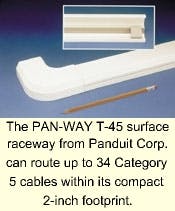Steve Smith
In New York City's financial district, the demand for news is growing so quickly that information providers are hard-pressed to keep up. CNNfn.com, said to be the Internet's leading source for business news, is trying to meet some of that demand by launching a full- service financial news, directory, search, and navigation service. But it means finding space at the CNN New York bureau for 90 more people. Ninety on-the-move people, that is. "One of their big concerns was for maximum flexibility in the cabling infrastructure," says Jerry Sullivan of the New York firm STUDIOS Architecture. "They didn't want cables in walls or in places that will require them to constantly have to unscrew access panels. They want to have the cables immediately available."
Part of STUDIOS's solution involved using the Wiremold Co.'s (W. Hartford, CT) SpecMate solid-bottom cable trays suspended from the office's open ceiling. But the key was designing a vertical raceway that brought the wires and cables from the overhead space down to the news desks. The raceway's removable cover will let CNNfn.com move workstations as necessary and get access to the overhead cabling with minimal disruption to adjacent workstations. "By allowing the client this much flexibility, future expansions and upgrades can be easily obtained," explains Sullivan.
A similar scenario was recently played out at the new Cinergy Corp. (Cincinnati) marketing and trading unit in Florence, KY, where telecommunications designers targeted individual workstation raceways as key to linking 100 constantly moving traders and 200 support personnel to a subfloor network containing multi-user outlet assemblies.
Raceway remains a constant
While keeping up with the industry's demands is becoming increasingly challenging for both client and installer, the relatively ancient raceway remains a constant, even if its role is changing. Not long ago, raceways were considered most useful in older buildings where in-wall wiring was impractical. Today, aesthetically pleasing raceways for ceiling, wall, and floor (and even subfloor) are considered cost-cutting essentials for even new buildings where frequent moves, adds, and changes are part of business (see Product Update table, page 70).
Most current raceways can route multiple wire types, including power and communications cables. But beyond versatility and aesthetics, a key consideration is making sure any fittings used to maneuver around a corner or tight space are fiber-friendly. Panduit Corp.'s (Tinley Park, IL) raceway systems, for example, boast 1-inch bend-radius control fittings that help designers maintain the recommended TIA/EIA bend radius for high-performance copper and fiber-optic cabling. (Data-transmission performance of Category 5 and optical-fiber cables can be degraded if bent excessively.)
"Physical protection for fibers off-frame is required to ensure that reliable, high-bandwidth services can be implemented," adds Michael McCahey, fiber products marketing-communications specialist at ADC Telecommunications Inc. (Minneapolis). "Raceway systems must offer speed and flexibility of installation to ensure jobs are done on budget and on time." To that end, ADC has developed what it calls a designer-friendly FiberGuide fiber-management system, with time-saving features such as an open-channel design where fibers can be laid in and retrieved without threading through an enclosure, and self-supporting straight raceway spans up to 6 ft that reduce support hardware installation. International Connectors and Cable Corp. (ICC-Cerritos, CA) is emphasizing installation speed with an adhesive-backed, one-piece design for its new raceway system.
Increased ease with in-the-field installation is also the purpose behind B-Line Systems' (Highland, IL) Wire Basket Runway, which sales engineer Mark McRae says "provides excellent cable support" with its zinc-plated steel composition and prepackaged installation kits and accessory options. PVC and plastic raceways, however, continue to surpass metal/steel composition in popularity, due primarily to durability and ease of cutting.
Best of both worlds
For those looking for the best of both worlds-durability without the cutting-Telect Inc.'s (Liberty Lake, WA) CableLinks cable-management system remains a unique alternative even after several years on the market. Its reusable, snap-fit design consists of individual plastic links and steel transitional components to enable rapid deployment.
Versatility and economy may be the primary drivers of the raceway market, but with network connectivity increasingly becoming a part of public and collegiate education, security and installation-specific needs are also being addressed by manufacturers. Panduit's PAN-WAY single-channel unit, for example, is a one-piece design that adds a highly tamper-resistant latch-ideal for warding off cabling mischief at school installations. Also targeting schools, but for another reason, is the Wiremold Co.'s new FiberReady elbow fittings for its 2300 and 2400 series raceways. The fittings feature 2-inch bend-radius fittings for small, low-profile surface raceways, suitable for education installations that typically require a limited number of power and telecommunications cables.
Joining a growing number of fiber-friendly raceways, the Wiremold Co.'s 2400 series is available with bend-radius fittings that provide performance protection for fiber-optic and high-performance copper cables.
CORRECTION
In the February 2000 issue (see "Packaging of termination and testing equipment," page 33), it was inadvertently reported that the formation of a 1-billion-bit-per-second protocol is currently in progress. In fact, the 10-Gigabit standard currently being considered by IEEE, not the 1-Gigabit standard that the group has already established for fiber- and copper-based Gigabit Ethernet transmission, should have been cited instead. Sorry for any confusion this may have caused.
